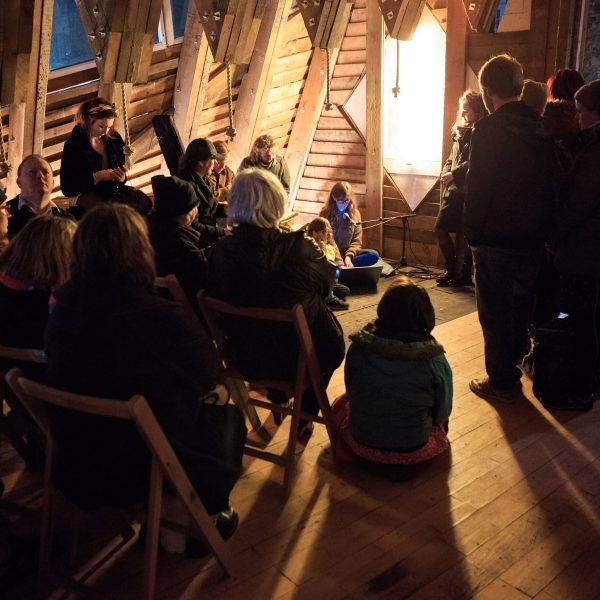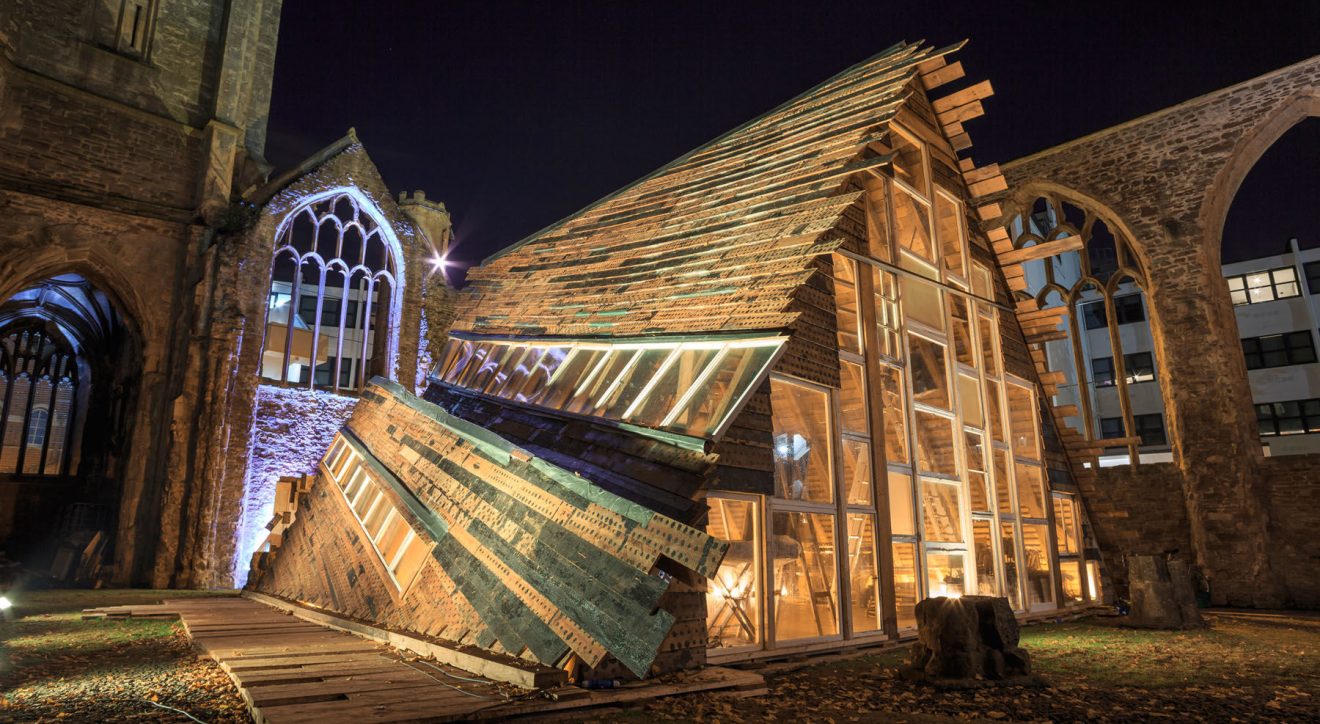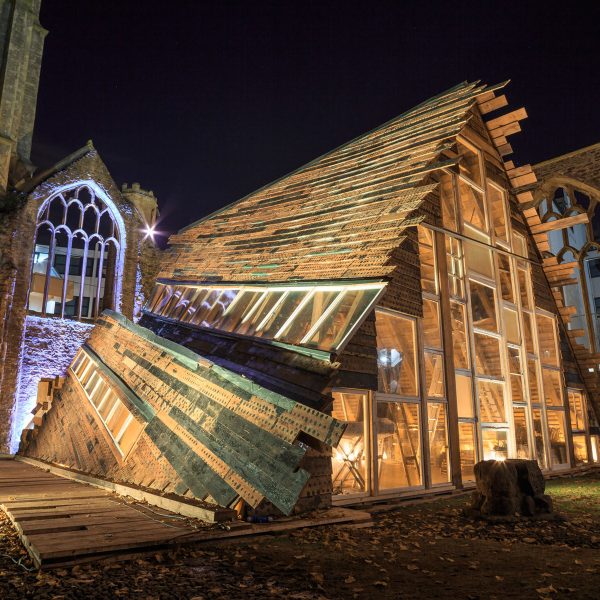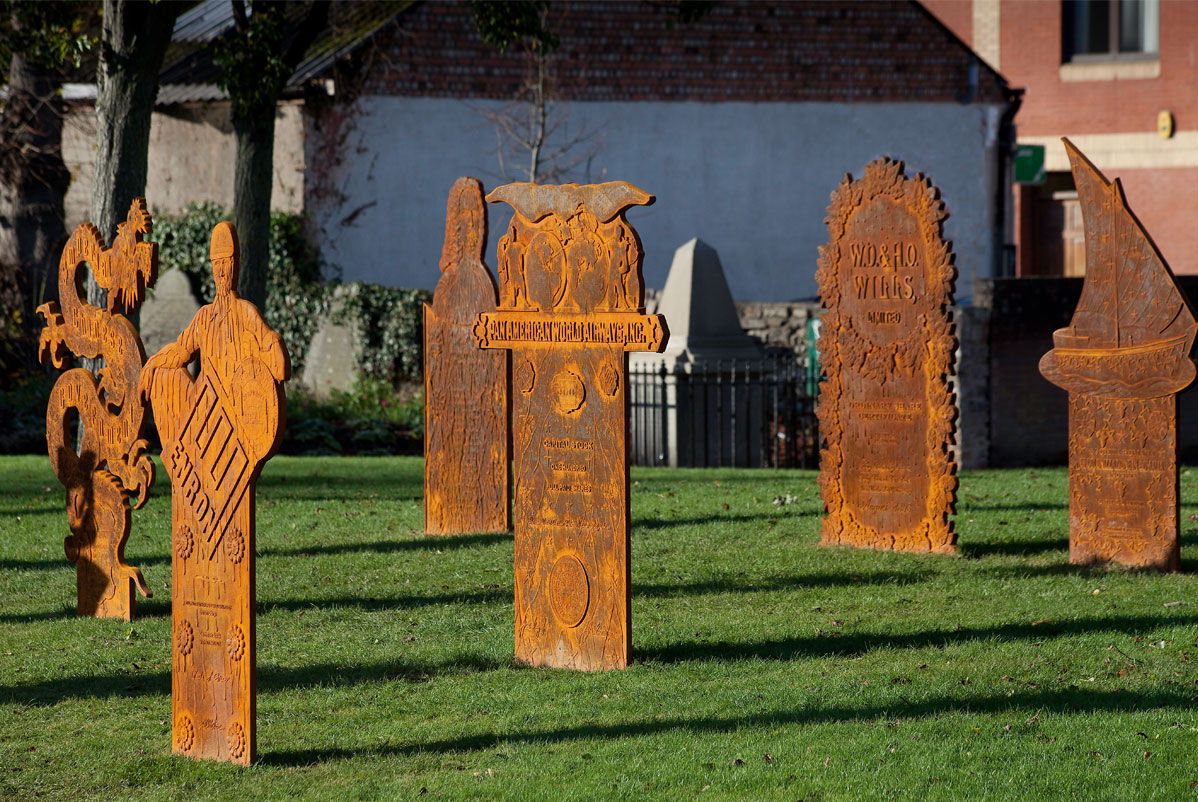
Synopsis
Between 6pm on 29th October 2015 until 6pm on 21st November 2015, Theaster Gates’ Sanctum hosted a continuous programme of sound over 552 hours, sustained by performers, musicians and bands in a temporary structure within the shell of Temple Church, Bristol. Sanctum was Theaster Gates’ first public project in the UK, produced by Situations, as part of Bristol 2015 European Green Capital. Open and free to visit day and night, the schedule remained secret.



Description
Situations believe in the capacity of artists to imagine new visions of the future for our environment and to sustain and enrich our lives. One of the foremost American artists of his generation, Theaster Gates is renowned for his acts of transformation, such as the re-activation and redemption of abandoned spaces and the redeployment of disused objects and materials.
In the autumn of 2015 a temporary structure rose within the remaining shell of the 14th century Temple Church for a continuous programme of performance. Having sought out discarded and dormant materials from former places of labour and religious devotion across the city Gates built this extraordinary work, working alongside AN-Architecture. Entitled Sanctum, the artist invited musicians and performers across Bristol to sustain a performance of sound and spoken word continuously for 24 days, 24 hours a day.
Sanctum was open to visitors day and night, capacity remaining limited to ensure the intimacy of the space. Whether a headlining band, spoken word artist or gospel choir this secret schedule contributed to the sense of Sanctum as a gathering space for collaboration and new encounters.
The project was developed through Gates’ working principle of seeing and reflecting upon the unseen, unvisited and under-heard. Gates sought the city’s voices, and tested how future spaces of contemplation might supersede the sanctuaries of the past.
Sanctum was a Situations project for Bristol 2015 European Green Capital funded by Arts Council England Exceptional Fund and the Henry Moore Foundation. The project was produced in Bristol in association with MAYK, BYEP (Babbasa Youth Empowerment Projects) and LARA (Lorraine Ayensu Refugee Arts) and in partnership with English Heritage.
Theaster Gates
Theaster Gates is an artist, musician and activist based in Chicago. Trained as both a sculptor and an urban planner, his artworks are rooted in social responsibility as well as a deep belief system. Gates often works with architects, researchers and performers to create artworks. His most acclaimed work, Dorchester Projects, began in 2009 with Gates transforming a cluster of buildings on Chicago’s South Side into alternative cultural spaces. Dorchester Projects has become a vibrant gathering point and place of work for many individuals from the neighbourhood. Gates is winner of the 2015 Artes Mundi prize, the founder of the non-profit Rebuild Foundation and currently Professor in the Department of Visual Arts, University of Chicago.
#sanctumbristol
Situations
Situations are award winning public art producers based in Bristol. Founded in 2002, Situations opens up the potential for artists to make extraordinary ideas happen in unusual and unexpected places, inspiring audiences and participants to explore new horizons. Previous projects have included Theaster Gates, Sanctum (2015), Hew Locke, The Jurors (2015) to commemorate the Magna Carta; Michael Sailstorfer, Folkestone Digs (2014); Annika Kahrs, Concert for the Birds (2014); Katie Paterson, Future Library (2014-2114) and Futurefarmers, Flatbread Society (2013 onwards) both for Oslo; Alex Hartley, Nowhereisland (2012); Heather and Ivan Morison, Black Cloud (2009); One Day Sculpture, New Zealand (2008). Situations is an Arts Council England National Portfolio organisation and is generously supported by the Esmée Fairbairn Foundation, the John Ellerman Foundation and the University of the West of England, Bristol.
Temple Church:
Bristol’s Temple Church on Temple Street, off Victoria Street, was the first English parish church to be taken into ownership by the then Ministry of Works, and is today in the care of English Heritage. It is a Grade II listed building and scheduled monument and is popularly known as Temple Church because the original circular church was built by the Knights Templar, recalling the Church of the Holy Sepulchre that stands in Jerusalem.
It was one of the largest of only a dozen such churches in England and it appears that the Bristol Temple became the administrative centre for the order in the South West. By 1307, however, the order had fallen into disrepute and their lands were later confiscated and handed to the Knights Hospitaller. When the Knights Hospitaller were themselves suppressed by Henry VIII in 1540, the church was taken over by the parish.
In the 18th century the interior was refitted. The shape of the original Templar church is now marked out on the ground. The chancel is exceptionally long and flanked by the chapel of St Nicholas to the north and the chapel of St Catherine to the south. The famous tower leans 5 feet (1.6 metres) out of the vertical.
The church was bombed during the Second World War and gutted by the resulting fire. Only the shell of the building, dating mainly from the 14th century, remained after the bombing on 24th November 1940, 75 years prior to the arrival of Sanctum. Temple Church is not usually open to the public so Sanctum offered rare chance to step inside the building.
Bristol European Green Capital 2015
Sanctum is one of six projects funded through an Exceptional Award from Arts Council England to support Bristol’s year as European Green Capital. The Bristol 2015 arts and culture programme was managed by Bristol Culture Development Partnership (BDCP).




